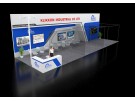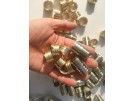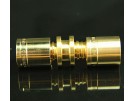Industry News
Brass types
Views: 1673 Update Date:Apr 03 , 2019
| Class | Proportion by weight (%) | Notes | |
|---|---|---|---|
| Copper | Zinc | ||
| Alpha brasses | > 65 | < 35 | Alpha brasses are malleable, can be worked cold, and are used in pressing, forging, or similar applications. They contain only one phase, with face-centered cubic crystal structure. With their high proportion of copper, these brasses have a more golden hue than others |
| Alpha-beta brasses | 55–65 | 35–45 | Also called duplex brasses, these are suited for hot working. They contain both α and β' phases; the β'-phase is body-centered cubic and is harder and stronger than α. Alpha-beta brasses are usually worked hot. The higher proportion of zinc means these brasses are brighter than alpha brasses. |
| Beta brasses[citation needed] | 50–55 | 45–50 | Beta brasses can only be worked hot, and are harder, stronger, and suitable for casting. The high zinc-low copper content means these are some of the brightest and least-golden of the common brasses. |
| Gamma brasses | 33–39 | 61–67 | There are also Ag-Zn and Au-Zn gamma brasses, Ag 30–50%, Au 41%.[26] |
| White brass | < 50 | > 50 | These are too brittle for general use. The term may also refer to certain types of nickel silver alloys as well as Cu-Zn-Sn alloys with high proportions (typically 40%+) of tin and/or zinc, as well as predominantly zinc casting alloys with copper additives. These have virtually no yellow coloring at all, and instead have a much more silvery appearance. |
| Alloy name | Proportion by weight (%) | Other | Notes | |||
|---|---|---|---|---|---|---|
| Copper | Zinc | Tin | Lead | |||
| Abyssinian gold | 90 | 10 |
|
|
|
|
| Admiralty brass | 69 | 30 | 1 |
|
|
Tin inhibits loss of zinc in many environments. |
| Aich's alloy | 60.66 | 36.58 | 1.02 |
|
1.74% iron | Designed for use in marine service owing to its corrosion resistance, hardness and toughness. A characteristic application is to the protection of ships' bottoms, but more modern methods of cathodic protection have rendered its use less common. Its appearance resembles that of gold.[27] |
| Aluminum brass | 77.5 | 20.5 |
|
|
2% aluminum | Aluminum improves corrosion resistance. It is used for heat exchanger and condenser tubes.[28] |
| Arsenical brass |
|
|
|
|
Arsenic; frequently aluminum | Used for boiler fireboxes. |
| Cartridge brass (C260) | 70 | 30 | — | ≤ 0.07[29] |
|
Good cold working properties. Used for ammunition cases, plumbing, and hardware. |
| Common brass | 63 | 37 |
|
|
|
Also called rivet brass. Cheap and standard for cold working. |
| DZR brass |
|
|
|
|
Arsenic | Dezincification resistant brass with a small percentage of arsenic. |
| Delta metal | 55 | 41–43 |
|
|
1–3% iron with the balance consisting of various other metals. | The proportions used make the material harder and suitable for valves and bearings. |
| Free machining brass (C360) | 61.5 | 35.5 |
|
3 | 0.35% iron | Also called 360 or C360 brass. High machinability. Lead content, 2.5–3.7%[29] |
| Gilding metal | 95 | 5 |
|
|
|
Softest type of brass commonly available. Gilding metal is typically used for ammunition bullet "jackets"; e.g., full metal jacket bullets. Almost red in color. |
| High brass | 65 | 35 |
|
|
|
Has a high tensile strength and is used for springs, screws, and rivets. |
| Leaded brass |
|
|
|
> 0 |
|
An alpha-beta brass with an addition of lead for improved machinability. |
| Lead-free brass |
|
|
|
< 0.25 |
|
Defined by California Assembly Bill AB 1953 contains "not more than 0.25 percent lead content".[14] Prior upper limit was 4%. |
| Low brass | 80 | 20 |
|
|
|
Light golden color, very ductile; used for flexible metal hoses and metal bellows. |
| Manganese brass | 70 | 29 |
|
|
1.3% manganese | Most notably used in making golden dollar coins in the United States.[30] |
| Muntz metal | 60 | 40 |
|
|
Traces of iron | Used as a lining on boats. |
| Naval brass | 59 | 40 | 1 |
|
|
Similar to admiralty brass. Also known as Tobin bronze.[31] |
| Nickel brass | 70 | 24.5 |
|
|
5.5% nickel | Used to make pound coins in the pound sterling currency. Also the main constituent of the bi-metallic One Euro coin and the centre part of the Two Euro coin. |
| Nordic gold | 89 | 5 | 1 |
|
5% aluminium | Used in 10, 20, and 50 cents euro coins. |
| Prince's metal | 75 | 25 |
|
|
|
A type of alpha brass. Due to its yellow color, it is used as an imitation of gold.[32] Also called Prince Rupert's metal, the alloy was named after Prince Rupert of the Rhine. |
| Red brass, Rose brass (C230) | 85 | 5 | 5 | 5 |
|
Both an American term for the copper-zinc-tin alloy known as gunmetal, and an alloy which is considered both a brass and a bronze.[33][34] Red brass is also an alternative name for copper alloy C23000, which is composed of 14–16% zinc, a minimum 0.05% iron and minimum 0.07% lead content,[29]and the remainder copper.[35] It may also refer to ounce metal, another copper-zinc-tin alloy. |
| Rich low brass, Tombac |
|
5–20 |
|
|
|
Often used in jewelry applications. |
| Silicon tombac | 80 | 16 |
|
|
4% silicon | Used as an alternative for investment cast steel parts. |
| Tonval brass |
|
|
|
> 0 |
|
Also called CW617N or CZ122 or OT58. It is not recommended for sea water use, being susceptible to dezincification.[36][37] |
| Yellow brass | 67 | 33 |
|
|
|
An American term for 33% zinc brass. |












